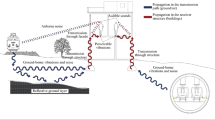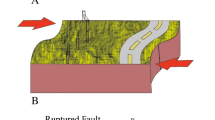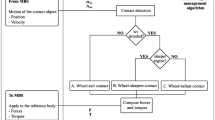Abstract
Rail corrugation is a common phenomenon in railway engineering, but its high-frequency effects on environmental vibrations are neglected in most previous research. Therefore, a hybrid numerical method was proposed in this paper to analyze subway-induced ground vibrations, especially in the high-frequency range caused by rail corrugation. The analysis model composed of a three-dimensional (3D) load generation subsystem and a two-dimensional (2D) wave propagation subsystem was established based on the vehicle-track coupling method and finite element method, and validated by the measured data. Then the high-frequency effects under different tunnel depths and rail fasteners were further studied. The results show that high-frequency vibrations propagate radially from the tunnel wall to the surrounding soil and transmit to the ground by the dominant path under different tunnel depths. The increase of tunnel depths could result in more serious high-frequency effects in the vibration amplification region. When the depth changes from 17 to 29 m, the 250 Hz ground vibration at around 30 m away from the track increases by 5.6 dB. Besides, it was found that in the commonly used range, the reduction of fastener stiffness can effectively eliminate high-frequency ground vibrations, while there is a significant nonlinear relationship between fastener damping and high-frequency vibration. The findings of this paper could provide references for parameter design in subway construction and rail corrugation remediation, and help create better living environments.












Similar content being viewed by others
Data availability
The datasets used and analyzed during the current study are available from the corresponding author on reasonable request.
References
Chen GX, Liu XZ (2004) Testing study on ratio of dynamic shear moduli and ratio of damping for recently deposited soils in Nanjing and its neighboring areas. Chinese J Rock Mech Eng 23:1403–1410
Chen GX, Zhou ZR, Ouyang H, et al (2010) A finite element study on rail corrugation based on saturated creep force-induced self-excited vibration of a wheelset-track system. J Sound Vib 329. https://doi.org/10.1016/j.jsv.2010.05.011
Collette C, Vanhonacker P, Bastaits R, Levy D (2008) Comparison between time and frequency studies of a corrugated curve of RER Paris network. Wear 265:1249–1258. https://doi.org/10.1016/j.wear.2008.01.030
Connolly DP, Marecki GP, Kouroussis G et al (2016) The growth of railway ground vibration problems — a review. Sci Total Environ 568:1276–1282. https://doi.org/10.1016/j.scitotenv.2015.09.101
Eadie DT, Santoro M, Oldknow K, Oka Y (2008) Field studies of the effect of friction modifiers on short pitch corrugation generation in curves. Wear 265:1212–1221. https://doi.org/10.1016/j.wear.2008.02.028
Feng CC, Liu XL, Li W et al (2018) Influence of short pitch rail corrugation on interior noise of metro vehicles. Noise Vib Control 38:113–117
Grassie SL (2009) Rail corrugation: characteristics, causes, and treatments. Proc Inst Mech Eng Part F J Rail Rapid Transit 223. https://doi.org/10.1243/09544097JRRT264
Grassie SL, Kalousek J (1993) Rail corrugation: characteristics, causes and treatments. Proc Inst Mech Eng Part F J Rail Rapid Transit 207. https://doi.org/10.1243/PIME_PROC_1993_207_227_02
Hall JF (2018) Performance of viscous damping in inelastic seismic analysis of moment-frame buildings. Earthq Eng Struct Dyn 47:2756–2776
Han M, Jiang J, Du H, Feng S (2021) Research on Damping Engagement Methodology in Dynamic Analysis of Isolated Structure. Shock Vib 2021:1–17. https://doi.org/10.1155/2021/6613952
Huang Q, Huang H, Ye B et al (2017) Dynamic response and long-term settlement of a metro tunnel in saturated clay due to moving train load. Soils Found 57:1059–1075. https://doi.org/10.1016/j.sandf.2017.08.031
ISO 3095–2005 (2005) Acoustics-Railway applications-Measurement of noise emitted by railbound vehicles
Jin QY, Thompson DJ, Lurcock DEJ et al (2018) A 2.5D finite element and boundary element model for the ground vibration from trains in tunnels and validation using measurement data. J Sound Vib 422:373–389. https://doi.org/10.1016/j.jsv.2018.02.019
Jin XS, Wen ZF, Zhang WH, Shen ZY (2005) Numerical simulation of rail corrugation on a curved track. Comput Struct 83https://doi.org/10.1016/j.compstruc.2005.03.012
Kouroussis G, Pauwels N, Brux P et al (2014) A numerical analysis of the influence of tram characteristics and rail profile on railway traffic ground-borne noise and vibration in the Brussels Region. Sci Total Environ 482–483:452–460. https://doi.org/10.1016/j.scitotenv.2013.05.083
Kouroussis G, Vogiatzis KE, Connolly DP (2017) A combined numerical/experimental prediction method for urban railway vibration. Soil Dyn Earthq Eng 97:377–386. https://doi.org/10.1016/j.soildyn.2017.03.030
Kuo KA, Verbraken H, Degrande G, Lombaert G (2016) Hybrid predictions of railway induced ground vibration using a combination of experimental measurements and numerical modelling. J Sound Vib 373:263–284. https://doi.org/10.1016/j.jsv.2016.03.007
Kurzeck B, Hecht M (2010) Dynamic simulation of friction-induced vibrations in a light railway bogie while curving compared with measurement results. Veh Syst Dyn 48:121–138. https://doi.org/10.1080/00423111003669045
Liu JB, Yin G, Du YX (2006) Consistent viscous-spring artificial boundaries and viscous-spring boundary elements. Chinese J Geotech Eng 28:1070–1075
Liu WN, Ren J, Liu WF et al (2011) Analysis of rail corrugation tests in Beijing subway. Urban Rapid Rail Transit 24:6–9
Liu XZ, Chen GX, Hu QX (2002) Primary study on dynamic shear modulus and damping ratio of recently deposited soil in area of Nanjing. Earthq Eng Eng Vib 22:127–131
Lopes P, Costa PA, Ferraz M et al (2014) Numerical modeling of vibrations induced by railway traffic in tunnels: from the source to the nearby buildings. Soil Dyn Earthq Eng 61–62:269–285. https://doi.org/10.1016/j.soildyn.2014.02.013
Lopes P, Ruiz JF, Alves Costa P et al (2016) Vibrations inside buildings due to subway railway traffic. Experimental validation of a comprehensive prediction model. Sci Total Environ 568:1333–1343. https://doi.org/10.1016/j.scitotenv.2015.11.016
Ma M, Liu WN, Sun N, Bin WW (2014) Reasons and laws of ground vibration amplification induced by vertical dynamic load. J Cent South Univ 21:1660–1671
Mazilu T (2010) Prediction of the interaction between a simple moving vehicle and an infinite periodically supported rail - Green’s functions approach. Veh Syst Dyn 48:1021–1042. https://doi.org/10.1080/00423110903248694
Meehan PA, Batten RD, Bellette PA (2016) The effect of non-uniform train speed distribution on rail corrugation growth in curves/corners. Wear 366–367:27–37. https://doi.org/10.1016/j.wear.2016.05.009
Ng AK, Martua L, Sun G (2019) Influence of sleeper distance on rail corrugation growth. Int Conf Intell Rail Transp ICIRT 2018:1–5. https://doi.org/10.1109/ICIRT.2018.8641668
Oostermeijer KH (2008) Review on short pitch rail corrugation studies. Wear 265:1231–1237. https://doi.org/10.1016/j.wear.2008.01.037
Qi LF, Wang AB, Xie YS et al (2019) Influence of different track structures in metro systems on the tunnel and ground vibration characteristics QI. Noise Vib Control 39:147–152
Sadeghi J, Esmaeili MH, Akbari M (2019) Reliability of FTA general vibration assessment model in prediction of subway induced ground borne vibrations. Soil Dyn Earthq Eng 117:300–311. https://doi.org/10.1016/j.soildyn.2018.11.002
Sanayei M, Maurya P, Moore JA (2013) Measurement of building foundation and ground-borne vibrations due to surface trains and subways. Eng Struct 53:102–111. https://doi.org/10.1016/j.engstruct.2013.03.038
Shen YK (2007) Study on the propagation laws of subway-induced vibration and isolation or reduction method of building vibration. Dissertation, Tongji University
Shih JY, Thompson DJ, Zervos A (2017) The influence of soil nonlinear properties on the track/ground vibration induced by trains running on soft ground. Transp Geotech 11:1–16. https://doi.org/10.1016/j.trgeo.2017.03.001
Shih JY, Thompson DJ, Zervos A (2016) The effect of boundary conditions, model size and damping models in the finite element modelling of a moving load on a track/ground system. Soil Dyn Earthq Eng 89:12–27. https://doi.org/10.1016/j.soildyn.2016.07.004
Sroczyński J, UrbańskaBonenberg L, Kumaszka F, Turczyński B (1978) Spectrum character of vibration and clinical form of vibration disease. Med Pr 29:193–200
Sutinen P, Zou J, Hunter LL, et al (2007) Vibration-Induced Hearing Loss. Otol Neurotol 28:171–177. https://doi.org/10.1097/MAO.0b013e31802e29f2
Wu TX, Thompson DJ (2005) An investigation into rail corrugation due to micro-slip under multiple wheel/rail interactions. Wear 258:1115–1125. https://doi.org/10.1016/j.wear.2004.03.060
Xin T, Wang S, Gao L et al (2020) Field measurement of rail corrugation influence on environmental noise and vibration: a case study in China. Meas J Int Meas Confed 164:108084. https://doi.org/10.1016/j.measurement.2020.108084
Xing MT, Zhao C.Y., Wang P, et al (2019) A numerical analysis of ground vibration induced by typical rail corrugation of underground subway. Shock Vib 2019.https://doi.org/10.1155/2019/8406813
Xu QY, Xiao ZC, Liu T et al (2015) Comparison of 2D and 3D prediction models for environmental vibration induced by underground railway with two types of tracks. Comput Geotech 68:169–183. https://doi.org/10.1016/j.compgeo.2015.04.011
Yang J, Zhu S, Zhai W et al (2019) Prediction and mitigation of train-induced vibrations of large-scale building constructed on subway tunnel. Sci Total Environ 668:485–499. https://doi.org/10.1016/j.scitotenv.2019.02.397
Yang YB, Liang XJ, Hung HH, Wu YT (2017) Comparative study of 2D and 2.5D responses of long underground tunnels to moving train loads. Soil Dyn Earthq Eng 97:86–100. https://doi.org/10.1016/j.soildyn.2017.02.005
Zhang B (2002) Engineering practice and theoretical analysis on vibration control of shallow underground engineering and related systems. Dissertation, China Academy of Railway Sciences
Zhao CY, Wang P, Yi Q (2017) Internal noise reduction in railway vehicles by means of rail grinding and rail dampers. Noise Control Eng J 65:1–13. https://doi.org/10.3397/1/376421
Zhu ZH, Liu YB, Wang LD et al (2020) Analysis of ground random vibration induced by subway transit based on 2.5-demensional finite element and pseudo excitation methods. China Railw Sci 41:29–39
Funding
This work was supported by the Beijing Nova Program (Z191100001119126), the Fundamental Research Funds for the Central Universities (2020JBM049), the Shanghai Key Laboratory of Rail Infrastructure Durability and System Safety (R202101) and the 111 Project (B20040).
Author information
Authors and Affiliations
Contributions
Sen Wang: formal analysis, data curation, writing—original draft, writing—review and editing, investigation. Tao Xin: conceptualization, methodology, formal analysis, writing—review and editing, funding acquisition. Pengsong Wang: data curation, writing—original draft, writing—review and editing. Yi Yang: writing—review and editing, investigation. Peng Chen: project administration, data curation. Lei Zhao: project administration, investigation, funding acquisition. Sihe Zhao: investigation, data curation. Yuming Luo: supervision, investigation.
Corresponding author
Ethics declarations
Ethics approval and consent to participate
Not applicable.
Consent for publication
Not applicable.
Competing interests
The authors declare no competing interests.
Additional information
Responsible Editor: Philippe Garrigues
Publisher's note
Springer Nature remains neutral with regard to jurisdictional claims in published maps and institutional affiliations.
Rights and permissions
About this article
Cite this article
Wang, S., Xin, T., Wang, P. et al. Numerical study on high-frequency effect of rail corrugation on subway-induced environmental vibrations. Environ Sci Pollut Res 29, 80657–80668 (2022). https://doi.org/10.1007/s11356-022-21264-0
Received:
Accepted:
Published:
Issue Date:
DOI: https://doi.org/10.1007/s11356-022-21264-0




